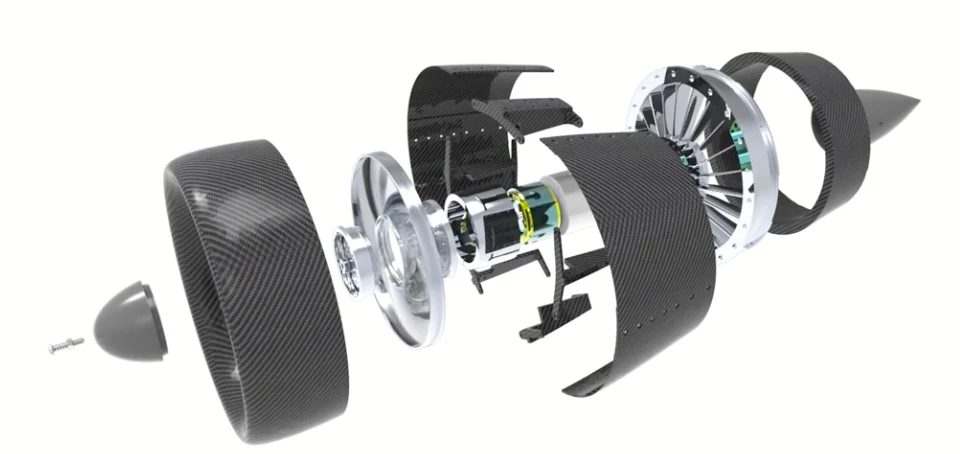Whisper Aero says its electric aircraft propulsion systems are "20% more efficient and 100x quieter than anything else on the market." They're designed for drones, planes and possibly eVTOLs, and there's also a funky-looking concept plane.
eVTOLs and delivery drones promise to bring large numbers of aircraft closer than ever before to urban life. Most people find today's drones annoyingly loud and wouldn't want them whirring overhead on a daily basis, and Whisper has raised some US$40 million and bagged some military grants on the basis that this company is building the quietest electric propulsion systems on the planet.
So for a company focused on silence, there's been a fair bit of noise around Whisper for a couple of years. Now, it's finally unveiled the technology it hopes will revolutionize electric aviation: an ultra-quiet, highly efficient electric ducted jet.
Inside the Whisper propulsion unit, there's a "propulsion disc" that's essentially a fan, one with an unusually large number of strong, stiff blades, joined at the outer circumference by a shrouding ring for additional strength. It's a small diameter fan, in order to keep the blade tip speed low while it's spinning at flight-relevant RPMs.

The large number of blades, Whisper says, push the "blade passage frequency" over 16,000 Hz, and thus out of the range of human hearing. Mind you, according to an interview with Aerospace America, the frequency doesn't push high enough to freak dogs out: "We’ve had five dogs in physical close proximity to our fan tests, and they don’t react at all to them,” said co-founder and CEO Mark Moore, who also co-founded Uber Elevate and worked as an engineer at NASA.
With lots of blades, you can also spin "way, way, slower than any propeller or turbofan," Moore continues. "We spin so slowly that the centrifugal forces on this rim aren't that significant that it would tear apart." That shrouding rim joining the fan tips also eliminates the gap between the blade tips and the duct housing, further reducing blade tip vortex noise.
Energy lost to noise is energy that's not converted to thrust, and Whisper says it's been able to demonstrate rotor efficiencies up to 92%, "even at 6-inch (15-cm) fan diameters."
In acoustic testing, Whisper's 6-inch fan tested as completely inaudible from 200 feet (61 m) away over a 30-decibel background noise floor. They then compared it against two ducted fans and two open propellers, described by Whisper as the quietest commercially available products on the market, all making the same 7.8 lbf (34.7 N) of thrust.
At 100 ft (30.5 m) distance, the whisper fan recorded a remarkable 34.1 dBA noise level. The Schubeler ducted fans measured 44.9 and 52.1 dBA, and the open propellers, from Aeronaut CAMcarbon, measured 49.4 and 58.7 dBA. You can hear the difference below.
According to Whisper, this shows that the company's propulsor is "100-500 times quieter than the ducted fans, and 100-1,000 times quieter than the open propellers."
Now I'm not a rocket surgeon, but I always thought the decibel scale, whether or not it's A-weighted, was a logarithmic measure of sound pressure level changes in which 10 decibels represents a tenfold increase in intensity, not a hundredfold. Perceptually, a 10 dB difference tends to "feel" more like a doubling of the noise level. So I can't square where that 100x figure comes from.
But either way, it does seem a ton quieter. The Tennessee-based company launched the propulsion system at the American Institute of Aeronautics and Astronautics' 2023 Aviaton Forum yesterday, presented with a mockup of a "Whisper Jet" designed to showcase the potential of the new fans.

The Whisper Jet concept is an odd-looking duck, using a Blohm and Voss Outboard Horizontal Tail (OHT) configuration something like Virgin Galactic's VSS Unity. It's got banks of propulsion units along its inner wing surfaces. Theoretically, it could carry a pilot and nine passengers, up to 200 miles (322 km) on a battery charge, at speeds up to 288 mph (463 km/h), using conventional runway takeoff and landing (CTOL). The range could be extended to 500-odd miles (800 km) with a hybrid system.
It's just a concept; Whisper is more interested in selling the propulsion system than going into the business of making planes. But the company says the propulsion system will work well for short takeoff and landing (STOL) aircraft, drones of all sizes, and potentially, eventually, eVTOL air taxis. It's working on a range of fan diameters, including 4-in, 10-in, and a 24-in option specifically designed for use in the AFWERX High Speed VTOL program, where it'll compete with some other fascinating propulsion technologies.
Low noise and high efficiency are certainly two important factors for electric aircraft. It'll be interesting to see how Whisper's units perform in the real world, and what kinds of clients pick this technology up and put it to work.
Source: Whisper Aero






